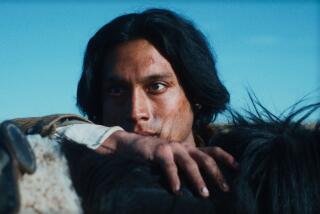COLUMN LEFT : The Castoffs of Unfettered Capitalism : In the new rush to market economics, some cautions from history should be heeded.
- Share via
ARDMORE, Ireland — Here in County Waterford on the last Saturday in May, Chief Hollis Roberts of the Choctaw Nation led a thousand people along the Trail of Tears--where 600 men, women and children died on a trek in search of food in 1849.
The Choctaw know all about such dark journeys. On their own Trail of Tears, in 1831, they were deported from southern Mississippi to Oklahoma. Along that forced march, 500 miles in the dead of winter, 14,000 Choctaws perished.
In 1847, in the Oklahoma Territory town of Skullville, the Choctaw heard of the famine devastating Ireland. They raised $710, an immense sum for people themselves almost destitute, and sent it across a continent and an ocean.
The 1990 march was organized by the voluntary group “Action From Ireland,” which invited Chief Roberts to lead them on the “famine walk” from Doolough to Louisburgh. Their walk, said the group’s statement, “symbolizes the continued suffering of millions of human beings on our planet today, who die of hunger and hunger-related diseases, caused by the same injustice and human-rights violations that crushed so many Irish and American Indians in the last century.”
It was eerie to turn from this moving episode of international solidarity to stories of Russian “radicals” cursing Gorbachev, himself mostly persuaded by their arguments, for being tardy in plunging the Soviet Union into the caldron of the capitalist market economy. Millions of the world’s most desperately hungry people suffer in these same capitalist economies that well-fed academics, politicians and journalists claim to be the success story of the late 20th Century.
In fact, the Great Famine of 1845-49 was one of the most determined tests of “free-market” economic discipline in human history. In those days, Ireland was a 19th-Century equivalent of El Salvador today, overcrowded with 8 million inhabitants, most of them on the edge of starvation. With their land largely in the hands of the British and used for export crops--a familiar story throughout Latin America today--the Irish were forced to rely on just one staple grown on the tiny plots that remained to them. When the potato blight struck, Irish peasants starved to death as their imperial masters, braced by liberal free-market theory, continued to export the grain that could have saved their lives, while proclaiming their concern that the victims of famine not become welfare clients, their moral fiber sapped by government handouts. A million died.
These days, according to the Quality of Life index devised by the United Nations Development Program, Ireland ranks 17th, two places ahead of the United States wither so many Irish fled after the famine. The criteria used to establish this ranking (which Japan tops) include literacy, life expectancy and social services as well as average income and wealth created. The author of the survey, Mahbub ul Haq, warns that social services are declining throughout Western countries: “There has been a drop in social spending from 17% of total expenditure to 10% over the last 10 years.” This is our old friend, capitalist market discipline, in action again--establishing the conditions in which more babies in poor families will die; in which poor people will be unhealthier and live shorter lives.
The Poles are learning what such discipline can mean, with 400,000 already out of work and 60,000 small businesses bankrupted since the austerity program began. The Czechs are about to taste some of the same medicine. The struggle in the Soviet Union is about the precise modalities of what the so-called radicals believe to be necessary pain.
There is nothing necessarily evil about a market, and the Soviet Union badly needs the flexibility of some market arrangements. But there is a great leap from this sort of market to the market relations and priorities of capitalism as it functions in large parts of Africa, Latin America and Asia, not to mention portions of the United States.
And what about the Choctaw? Where did their Trail of Tears take them? There are about 19,000 on tribal lands in Oklahoma. To ward off cultural disintegration and to battle 37% unemployment, they have installed a vigorous system of social services, with a free hospital, three clinics, 70 pounds of food a month for those in need, tuition supports, low-income housing. Chief Roberts says money for this comes partly from bingo and substantially from subcontracted work for firms such as Boeing and Lockeed. Thus sustained with proceeds from gambling and the military-industrial complex do the Choctaws try to steer clear of the trail of tears.
More to Read
Sign up for Essential California
The most important California stories and recommendations in your inbox every morning.
You may occasionally receive promotional content from the Los Angeles Times.













